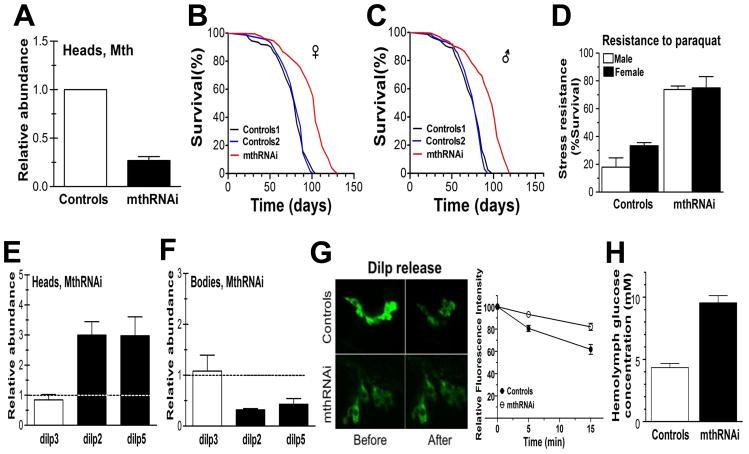Fig 1.
RNAi knockdown of mth expression in fly IPCs significantly increases longevity and stress resistance. Both Dilp2-GAL4 and UAS-mthRNAi lines were backcrossed into w1118 for 10 generations. (A) Genomic RNAi targeted to the IPCs reduces expression of mth approximately 4-fold and data has been normalized to control that is one (B). Mean female longevity in mthRNAi flies was 104 days compared with an 82 d average in the two control lines, for males (C) analogous values were 98 days and 76 days, respectively. Longevity differences between mthRNAi and control lines were statistically significant at p < 0.0001 (Mantel-Cox log-rank test) for both sexes. (D) Resistance to 20μM of the reactive oxygen species generator paraquat is also significantly enhanced in flies with IPC-specific mthRNAi (p < 0.001, Student t-test, for both sexes). Survival shown after at 24 h exposure. (E) RT-PCR of brain-specific Dilp messages indicates that IPC targeted mthRNAi increases the abundance of Dilp2 and Dilp5 in the brain and dotted line represents the control as one but (F) reduces secretion from IPCs such that abundance in the body is lower and dotted line represents control as one There was no significant effect on Dilp3 production (G) Direct measurement of K+-stimulated DILP2 secretion shows reduced rate of disappearance of GFP-tagged DILP2 in IPC-specific mthRNAi flies compared with controls. DILP release was stimulated by high (97mM) K+ and Ca2+. Before = before K+ stimulation, After = after 15 minutes Ca++ and K+ stimulation. (H) Hemolymph glucose concentration was approximately doubled in IPC mthRNAi flies compared with controls. Control 1 = w1118 x Dilp2-GAL4; Control 2 = w1118 x UAS-mthRNAi; mthRNAi = UAS-mthRNAi x Dilp2-GAL4.

